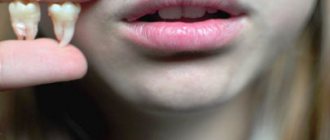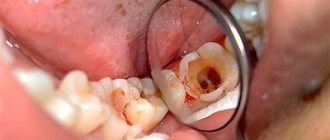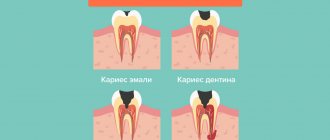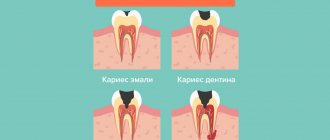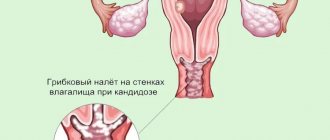When deep caries reaches the dental nerve, pulpitis begins - during pregnancy it is much more severe than in ordinary patients. And if the expectant mother postpones a visit to the doctor and suffers pain, this can affect the baby’s health.
Untreated pulp inflammation becomes chronic with periodic exacerbations, and there is a high risk of serious purulent complications. Sluggish pulpitis in pregnant women contributes to the penetration of infection into the blood, which means that the developing fetus may also suffer. Therefore, at the first signs of illness, you should see a dentist, for example, come to the VAODENT clinic.
Pulpitis in pregnant women
A pregnant woman's teeth are especially susceptible to the negative effects of pathogenic bacteria. This contributes to the more frequent development of caries and pulpitis. There are several reasons why a pregnant woman's teeth are more susceptible to disease:
- The development of pulpitis is promoted by saliva, the composition of which is influenced by changes in hormonal levels.
- Contact with enamel of vomit during toxicosis. They have a low level of acidity, which leads to thinning of tooth enamel.
- Supplying gums with plenty of blood. The gums become loose and susceptible to the negative influence of bacteria. As a result of inflammation, caries appears, developing into pulpitis.
- A large amount of calcium is required for normal fetal development. The lack of this element in the body of the expectant mother leads to tooth decay.
If pain occurs, you should consult a specialist. The method of treating the disease is determined by the dentist. Delaying treatment can lead to complications and the development of other diseases.
Characteristics of the pathology
This disease is an inflammatory process in the dental pulp. Inflammation can develop if caries treatment is not carried out in a timely manner. The disease begins to progress and eventually affects internal tissues.
In pregnant women, the situation is complicated by hormonal imbalances and a constant lack of minerals and trace elements in the body. The main role here is played by a lack of calcium, due to which the skeletal system is formed and maintained. In this case, not only the pain syndrome, which significantly complicates the life of the expectant mother, is important, but also the detrimental effect of the inflammatory process on the child in the womb.
It is possible and even necessary to treat the pulp in this condition. If the situation is left to chance, a progressive infection can cause significant harm, and only timely intervention by a dentist will help avoid serious problems and numerous complications.
Remember, a pregnant woman should take any medications (analgesics) only after consulting a doctor.
The need for treatment of pulpitis
Some women do not know whether they should have dental treatment during pregnancy, or whether the procedure should be postponed until postpartum. Pulpitis must be treated when it appears. Several reasons requiring immediate treatment of the disease:
- Pulpitis is inflammation of the neurovascular bundle of the tooth. Untimely treatment leads to the absorption of bacteria into the blood of the expectant mother. This can lead to fetal developmental disorders.
- Presence of acute throbbing pain. Promotes the production of large amounts of hormones. This negatively affects the development of the child. Severe toothache can lead to uterine contractions and premature birth.
- Infection in the gastrointestinal tract. Infections that enter the gastrointestinal tract from the tooth can lead to late toxicosis.
Taking into account the above factors, a pregnant woman should immediately consult a dentist if symptoms of pulpitis appear.
Pulpitis during pregnancy: myths
For a long time, there has been a persistent misconception that it is impossible to treat teeth while carrying a child, since this can negatively affect the health of the fetus. Despite the fact that medicine has long stepped forward, many pregnant women today refuse treatment out of fear and prejudice. Meanwhile, untreated caries and pulpitis pose a serious danger to the health of the mother and child, since they are constant sources of infection in the body, reduce immunity and can cause blood poisoning and other dangerous complications.
Treatment of pulpitis necessarily includes radiography to obtain objective information about the condition of the internal tissues of the tooth, as well as to check the quality of canal filling. The need to be exposed to X-ray radiation causes fear in many expectant mothers, as a result of which they refuse treatment. X-rays do have a mutagenic effect and can have an effect on the fetus. However, modern equipment allows diagnostics to be carried out with a minimum dose of radiation; In addition, during radiography, special protective equipment is used that almost completely eliminates the effect of radiation on the child. The risk of developing complications in the absence of treatment for pulpitis is much higher than the risk of negative consequences of radiography.
Another persistent myth that causes expectant mothers to refuse treatment is the use of arsenic to kill the inflamed pulp before its removal. Indeed, until recently, drugs based on this toxic substance had practically no replacement. However, today there are methods for treating pulpitis that do not require preliminary killing of the pulp, as well as preparations for depulpation, which do not contain arsenic and other substances that can have a negative effect on the fetus.
How long does it take to treat pulpitis?
Treatment of pulp inflammation has features depending on the stage of pregnancy. The expectant mother needs to inform the dentist about her situation and the stage of pregnancy. The specialist will select medications that will not harm the baby’s health for a certain period of time.
First trimester (from the moment of conception to the 12th week inclusive)
Treatment of pulpitis in pregnant women in the first trimester is not recommended. During this period, the fetus experiences increased sensitivity to toxins. The use of even the safest anesthesia can provoke developmental disorders.
The need for treatment is determined by the dentist. Treatment of chronic pulpitis is postponed to a later date. In the first trimester, the disease is treated during exacerbation.
Second trimester (from week 13 to week 28 inclusive)
At this time, the likelihood of harm to the fetus during dental treatment is reduced. The second trimester is the most favorable period for the treatment of pulpitis during pregnancy. The doctor performs the treatment under local anesthesia. Drugs are used that have a minimal amount of vasoconstrictor substances and do not penetrate the placenta. Such medications do not harm the baby.
Third trimester (from 29 weeks until birth)
The presence of acute toothache in a pregnant woman in the later stages can lead to premature birth. In the third trimester, treatment of pulpitis is necessary. Before visiting the dentist, you should consult with a gynecologist accompanying your pregnancy.
Therapy
| Service | price, rub. |
| Primary consultation and examination with a doctor | For free |
| Initial consultation with an implantologist, orthodontist, orthopedist (orthopantomogram is required) | For free |
| Repeated examination without prescribing treatment | For free |
| Examination by a doctor with prescription of medication | 500 |
| Help for antenatal clinics, hospitals, sanatoriums | 500 |
| TREATMENT OF CARIES | |
| Treatment of caries “without drilling” ICON technology – 1 tooth | 3000 |
| Treatment of caries (filling, anesthesia, lining) | 2700 — 4200 |
| Treatment of deep caries (filling, anesthesia, x-ray, lining) | 3800 — 5100 |
| Artistic tooth restoration (frontal group of teeth) | 4800 — 6700 |
| Restoration of a chewing tooth (filling, gasket, anesthesia, x-ray, pin) | 3600 — 4600 |
| NERVE REMOVAL – CANAL TREATMENT (depulpation) is carried out in two visits, payment in stages, includes x-rays, anesthesia, canal treatment, temporary filling | |
| Treatment of pulpitis of a 1-canal tooth, without the cost of a filling | 4400 — 5500 |
| Treatment of pulpitis of a 2-channel tooth, without the cost of a filling | 6500 — 7600 |
| Treatment of pulpitis of a 3-channel tooth, without the cost of a filling | 8600 — 9700 |
| Treatment of pulpitis of a 4-channel tooth, without the cost of a filling | 10700 — 11800 |
| Installing a seal | 3200 — 3600 |
Consultation is free.
Our teeth consist of hard tissues (dentin and cement) and enamel covering them. Any tooth has a cavity from which the entrances to the canals open, which are located inside the tooth root. The neurovascular bundle passes through the canal. Doctors call it pulp. Patients often use the expression “dental nerve.”
When the neurovascular bundle becomes inflamed, an acute disease develops - pulpitis, which is usually accompanied by pain. The pain can be of varying intensity; usually the tooth reacts to cold and hot and hurts at night.
Any pain in the body is a signal to the owner that something has happened. Pain cannot be tolerated: such “heroism” and self-medication can lead to the development of more serious diseases and complications.
So, is it possible to treat pulpitis during pregnancy and what will happen if it is postponed until the postpartum period?
Stages of treatment
Treatment of pulpitis is carried out in one or several visits to the doctor. Treatment is carried out in several stages:
- Diagnostics. The doctor conducts a survey and examination of the pregnant woman’s oral cavity.
- Introduction of anesthesia. The drugs used are safe for the fetus.
- Removal of the part of the tooth affected by caries.
- Pulp removal. A pulp extractor is used - a rod with spikes that engage the tissue.
- Cleaning of channels and their mechanical treatment.
- Installation of a seal. The root canals and crown part of the tooth are filled.
- Checking the filling of the canals using radiography.
In some cases, treatment is carried out in 2–3 visits to the doctor. For the period between appointments, the doctor installs a temporary filling. It protects the tooth cavity from food and pathogenic bacteria.
What to do during pregnancy with pulpitis and periodontitis
During pregnancy, many problems are caused by diseases of the pulp and bones surrounding the tooth - pulpitis and periodontitis. They are accompanied by severe pain and require immediate treatment, including disinfection, cleaning, root canal filling, and pulp removal. These interventions require anesthesia; due to poor visual access, doctors are forced to perform an X-ray examination, which frightens patients with possible negative consequences. However, sanitation is necessary, otherwise the problem will worsen and may lead to tooth extraction. The dentist will select an approved painkiller and microdoses of radiation and safely solve the problem.
Use of radiography
Treatment of pulpitis involves the use of x-rays. They are necessary for the dentist for diagnostics, high-quality cleaning of root canals from inflamed pulp and control over the quality of the work performed.
The dentist must take into account the individual characteristics of each patient’s teeth. To determine the depth, location and curvature of the root canals, the specialist needs to send the expectant mother for an x-ray. This will allow him to get a more detailed picture and correctly treat pulpitis.
Radiography during dental treatment does not harm the health of the fetus. The rays pass through the tissue in the tooth area. A specialized apron that does not transmit x-ray radiation is put on a pregnant woman's stomach. This makes the procedure safe for the baby.
Treatment of pulpitis during pregnancy is necessary. The presence of the disease can negatively affect the fetus. A timely visit to the dentist will help avoid complications and the development of other diseases.
Symptoms of pulpitis and how does pulpitis differ from caries?
Pulpitis is the process of inflammation of the nerve bundle of the tooth - the pulp, otherwise soft tissue in the tooth cavity.
This part of the structure of the teeth is extremely sensitive, and any infection entering “its territory” begins to progress rapidly and causes noticeable pain, since it is located not so far from the nerve endings.
And the most common cause of the development of pulpitis is unattended caries (neglected or not cured in time).
The cause can also be not only deep caries or a crack, but also, for example, an accidental burn during tooth treatment or preparation for the installation of dentures. With rare exceptions, cases can be observed when an infectious infection enters the depths of the tooth, that is, the pulp, through the blood directly.
The symptomatic accompaniment of this disease can often be confused with a severe form of caries, since you begin to react more strongly to cold or hot, sometimes even spicy and salty (depending on the complexity and depth of inflammation of the dental pulp and the proximity of nerve endings). Sharp pain can in some cases be accompanied by bleeding. But there are still a number of specific differences in comparing these two diseases. The main difference is that with caries, only the walls of the tooth are affected, without affecting the insides, but with pulpitis, the nerve endings come under attack.
Pulpitis is considered to be approximately the third stage of caries development, while symptomatic deterioration will rapidly expand its list from tooth sensitivity to temperature changes, right up to acute pain, creating discomfort when eating food and even liquids.
Anesthesia: endure or treat teeth with painkillers
For many years, pregnancy and anesthetics were considered incompatible. Expectant mothers preferred to stoically endure pain and discomfort during treatment, causing harm to themselves and the baby through stress. Today, thanks to modern drugs, teeth are successfully sanitized under anesthesia, which is not harmful during pregnancy. Their impact is not comparable to the harm caused by severe pain. It disrupts a woman’s emotional state, provokes disruptions in metabolism and the functioning of internal organs, and takes the central nervous system out of control.
At the border of dentin and enamel, the density of nerve endings is greatest, so unpleasant sensations in the tooth appear even with minor damage. During pregnancy, help is needed at the slightest discomfort and should never be tolerated. The doctor needs to inform the deadline, take an exchange card to the appointment, he will select a drug that eliminates the pain and carry out treatment without discomfort. During pregnancy, local anesthetics with a small proportion of adrenaline are allowed - they do not penetrate the hemoplacental protection. The well-known lidocaine is not recommended: it weakens the expectant mother, provokes muscle spasms and lowers blood pressure. Modern products are hypoallergenic, non-toxic, and well tolerated. Doctors consider the following to be the optimal drugs:
- ultracaine - it is allowed both during pregnancy and at the lactation stage, since it does not accumulate in milk;
- Primacaine with a minimal percentage of penetration through the placental protection - it has a short half-life, it is allowed even for small children;
- ubistezin, alfacaine, artifrin and other drugs based on anticaine.
In any case, the doctor will clarify how the pregnancy is progressing, select the minimum, necessary and sufficient dose, and recommend approved medications to take after treatment in the office.
Family Dentist Clinic: dental care for pregnant women
In our clinic, dentistry for pregnant women is well developed:
- We use a safe local anesthetic - Ultracaine with an adrenaline concentration of 1:200,000. The active substance articaine penetrates the placenta in minimal quantities, provides a reliable analgesic effect, does not increase heart rate, and is quickly eliminated from the body.
- If there is an urgent need for examination, we take a dental photograph with a digital radiovisiograph and additionally protect the abdomen with an apron. The beam of the device is directed only at the tooth, the radiation dose is low, comparable to a walk in the summer sun.
- An ergonomic chair ensures optimal position of the spine without muscle strain.
- Patient and attentive doctors help relieve anxiety and nervous tension, answer all questions in detail, and give recommendations on taking vitamins and oral hygiene.
- Materials for filling, aesthetic composites are non-toxic, blend with the shade of tooth enamel. The restorations look as natural as possible.
Effect on the fetus
It is not for nothing that dentists insist that treatment of pulpitis in pregnant women cannot be delayed. The influence of x-ray radiation and anesthesia, although undesirable during this period, is less dangerous than the risk of infection of the unborn child:
- the inflamed pulp becomes a source of infection, from which toxins and pathogens enter the mother’s circulatory system, risking infecting the fetus;
- The emotional mood of the mother has a strong influence on the condition and intrauterine development of the child. His health may suffer due to the effects of hormones released during severe pain from pulpitis;
- the use of anesthesia in the treatment of pulpitis in the first trimester of pregnancy is dangerous because deviations in the intrauterine development of the child are possible;
- a problematic tooth is a breeding ground for infections that can affect the body of a newborn baby, because they have constant close contact with their mother.
